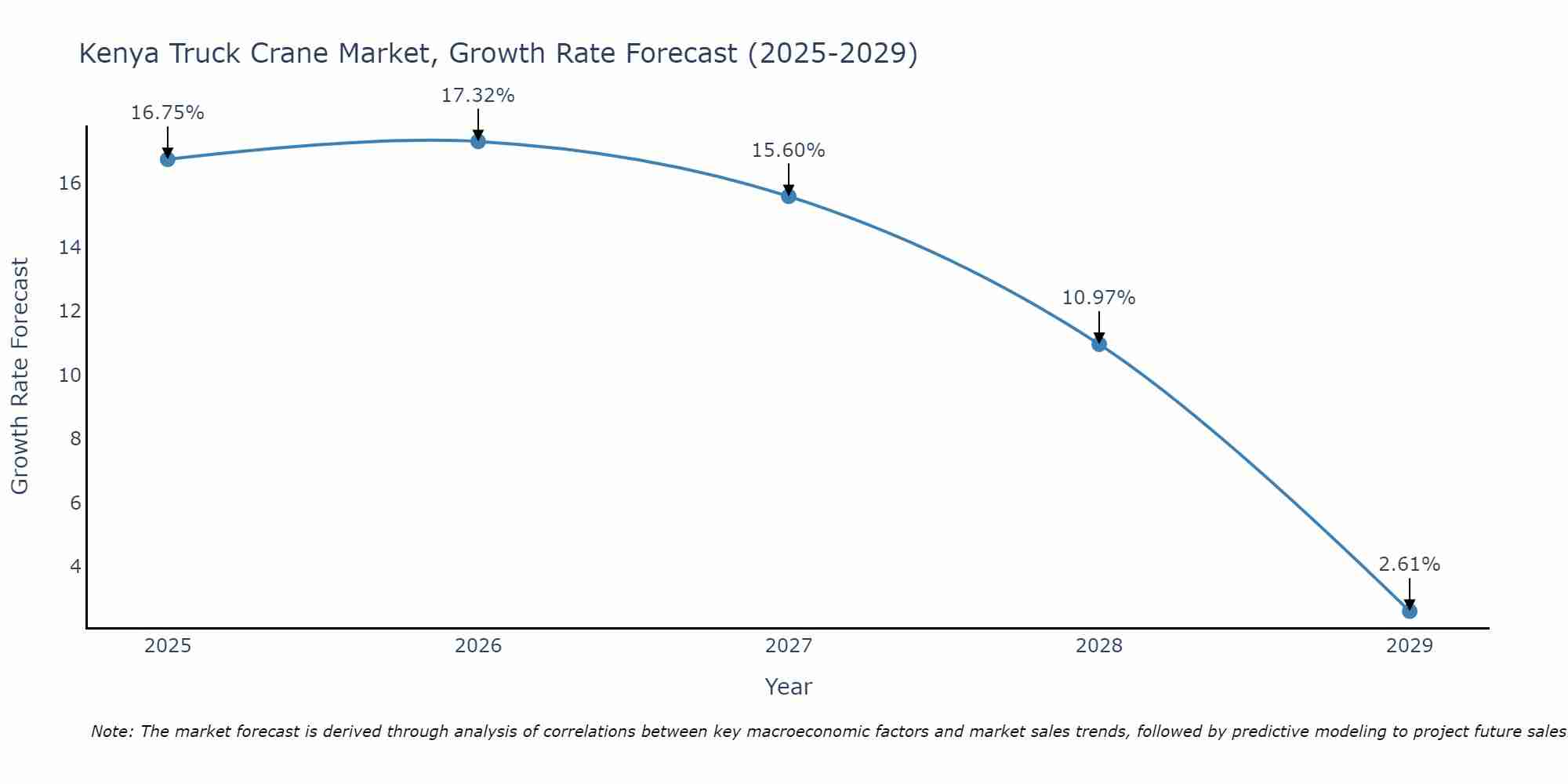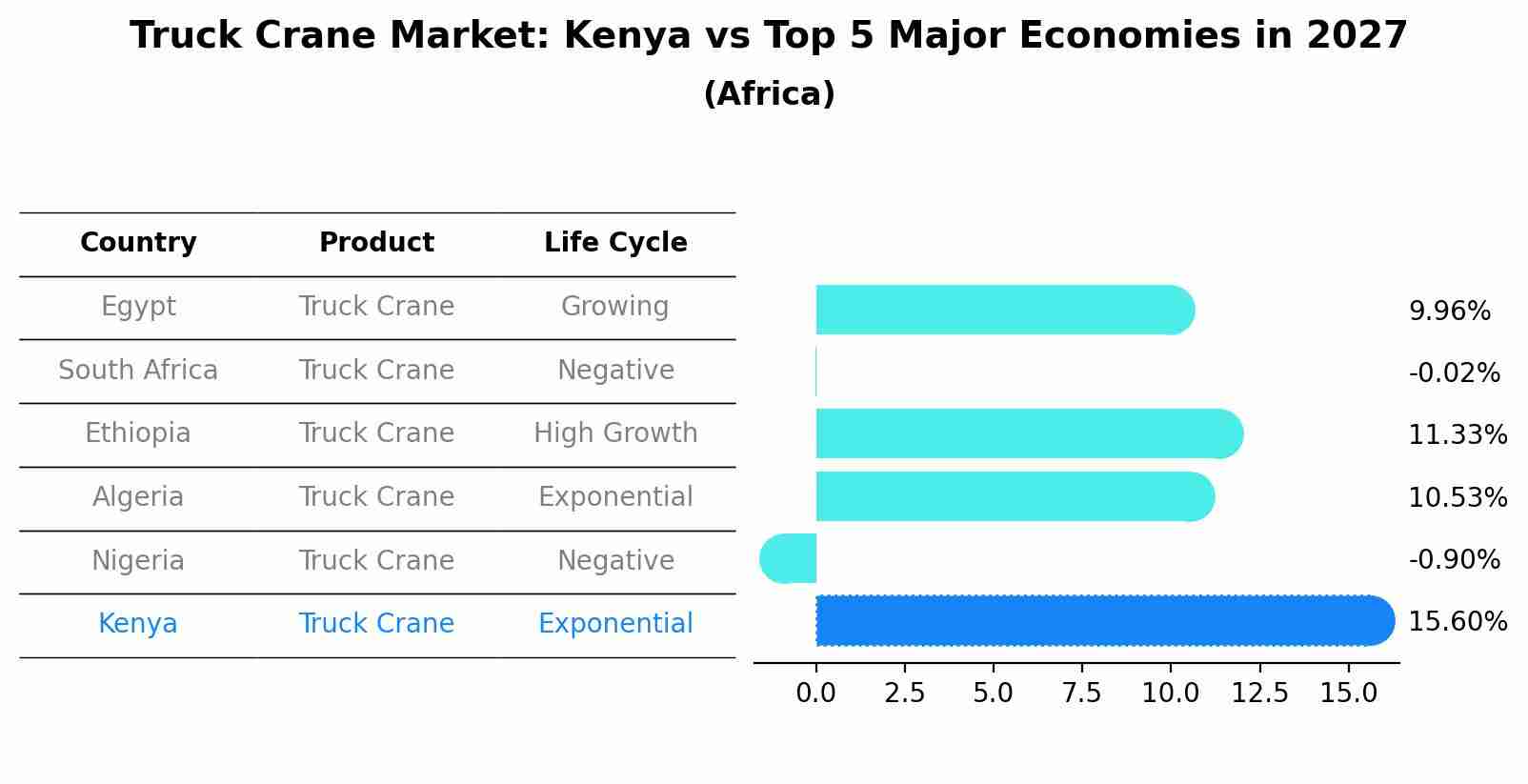Kenya Truck Crane Market | Size, Revenue, Value, Industry, COVID-19 IMPACT, Growth, Analysis, Share, Companies, Trends & Forecast
| Product Code: ETC174069 | Publication Date: Jan 2022 | Updated Date: Aug 2025 | Product Type: Market Research Report | |
| Publisher: 6Wresearch | Author: Ravi Bhandari | No. of Pages: 70 | No. of Figures: 35 | No. of Tables: 5 |
Kenya Truck Crane Market Size Growth Rate
The Kenya Truck Crane Market is projected to witness mixed growth rate patterns during 2025 to 2029. The growth rate begins at 16.75% in 2025, climbs to a high of 17.32% in 2026, and moderates to 2.61% by 2029.

Truck Crane Market: Kenya vs Top 5 Major Economies in 2027 (Africa)
Kenya's Truck Crane market is anticipated to experience a exponential growth rate of 15.60% by 2027, reflecting trends observed in the largest economy Egypt, followed by South Africa, Ethiopia, Algeria and Nigeria.

Kenya Truck Crane Market Overview
The Kenya truck crane market is expanding due to infrastructure development and construction projects. Truck-mounted cranes are preferred for their mobility and versatility across various industries.
Drivers of the market
The Kenya Truck Crane Market is driven by the growth of the construction, infrastructure development, and logistics industries, which require efficient lifting and material handling solutions. Truck cranes offer versatility, mobility, and cost-effectiveness, making them indispensable for various applications such as construction, mining, and transportation of heavy cargo. The ongoing investment in infrastructure projects, including roads, bridges, and commercial buildings, increases the demand for truck cranes to facilitate material handling and construction activities. Moreover, the expansion of logistics and freight transport sectors necessitates the use of truck cranes for loading and unloading goods, driving market growth further. Additionally, technological advancements such as telematics integration and remote monitoring enhance the efficiency and safety of truck crane operations, contributing to market expansion.
Challenges of the market
The Kenya Truck Crane Market encounters challenges stemming from infrastructure limitations, regulatory constraints, and economic volatility. Inadequate road infrastructure and limited access to construction sites hinder the deployment and operation of truck cranes in Kenya. Moreover, regulatory hurdles related to vehicle size and weight restrictions impose limitations on the design and functionality of truck crane systems. Economic fluctuations and currency exchange risks further compound the challenges faced by manufacturers and operators in the truck crane market. Additionally, ensuring operator safety and skills development poses ongoing challenges for the adoption and utilization of truck crane technology in Kenya.
Government Policy of the market
The Kenya government has formulated policies to promote the truck crane market. These policies include licensing and safety regulations for crane operators, import duties on truck cranes, and incentives for local assembly and manufacturing of truck cranes to support the domestic industry.
Key Highlights of the Report:
- Kenya Truck Crane Market Outlook
- Market Size of Kenya Truck Crane Market, 2021
- Forecast of Kenya Truck Crane Market, 2028
- Historical Data and Forecast of Kenya Truck Crane Revenues & Volume for the Period 2018 - 2028
- Kenya Truck Crane Market Trend Evolution
- Kenya Truck Crane Market Drivers and Challenges
- Kenya Truck Crane Price Trends
- Kenya Truck Crane Porter's Five Forces
- Kenya Truck Crane Industry Life Cycle
- Historical Data and Forecast of Kenya Truck Crane Market Revenues & Volume By Type for the Period 2018 - 2028
- Historical Data and Forecast of Kenya Truck Crane Market Revenues & Volume By Mounted Crane for the Period 2018 - 2028
- Historical Data and Forecast of Kenya Truck Crane Market Revenues & Volume By Sidelift Crane for the Period 2018 - 2028
- Historical Data and Forecast of Kenya Truck Crane Market Revenues & Volume By Boom Truck Crane for the Period 2018 - 2028
- Historical Data and Forecast of Kenya Truck Crane Market Revenues & Volume By Applications for the Period 2018 - 2028
- Historical Data and Forecast of Kenya Truck Crane Market Revenues & Volume By Construction for the Period 2018 - 2028
- Historical Data and Forecast of Kenya Truck Crane Market Revenues & Volume By Industries for the Period 2018 - 2028
- Historical Data and Forecast of Kenya Truck Crane Market Revenues & Volume By Utilities for the Period 2018 - 2028
- Kenya Truck Crane Import Export Trade Statistics
- Market Opportunity Assessment By Type
- Market Opportunity Assessment By Applications
- Kenya Truck Crane Top Companies Market Share
- Kenya Truck Crane Competitive Benchmarking By Technical and Operational Parameters
- Kenya Truck Crane Company Profiles
- Kenya Truck Crane Key Strategic Recommendations
Frequently Asked Questions About the Market Study (FAQs):
1 Executive Summary |
2 Introduction |
2.1 Key Highlights of the Report |
2.2 Report Description |
2.3 Market Scope & Segmentation |
2.4 Research Methodology |
2.5 Assumptions |
3 Kenya Truck Crane Market Overview |
3.1 Kenya Country Macro Economic Indicators |
3.2 Kenya Truck Crane Market Revenues & Volume, 2021 & 2028F |
3.3 Kenya Truck Crane Market - Industry Life Cycle |
3.4 Kenya Truck Crane Market - Porter's Five Forces |
3.5 Kenya Truck Crane Market Revenues & Volume Share, By Type, 2021 & 2028F |
3.6 Kenya Truck Crane Market Revenues & Volume Share, By Applications, 2021 & 2028F |
4 Kenya Truck Crane Market Dynamics |
4.1 Impact Analysis |
4.2 Market Drivers |
4.2.1 Increasing infrastructure development projects in Kenya leading to higher demand for construction equipment including truck cranes. |
4.2.2 Growth in industries such as mining, oil gas, and manufacturing driving the need for efficient material handling equipment like truck cranes. |
4.2.3 Government initiatives and investments in enhancing transportation and logistics infrastructure driving the demand for truck cranes. |
4.3 Market Restraints |
4.3.1 High initial investment costs associated with purchasing and maintaining truck cranes may hinder market growth. |
4.3.2 Fluctuating fuel prices impacting operational costs for truck crane operators. |
4.3.3 Limited skilled labor for operating and maintaining truck cranes leading to potential challenges in adoption and utilization. |
5 Kenya Truck Crane Market Trends |
6 Kenya Truck Crane Market, By Types |
6.1 Kenya Truck Crane Market, By Type |
6.1.1 Overview and Analysis |
6.1.2 Kenya Truck Crane Market Revenues & Volume, By Type, 2018 - 2028F |
6.1.3 Kenya Truck Crane Market Revenues & Volume, By Mounted Crane, 2018 - 2028F |
6.1.4 Kenya Truck Crane Market Revenues & Volume, By Sidelift Crane, 2018 - 2028F |
6.1.5 Kenya Truck Crane Market Revenues & Volume, By Boom Truck Crane, 2018 - 2028F |
6.2 Kenya Truck Crane Market, By Applications |
6.2.1 Overview and Analysis |
6.2.2 Kenya Truck Crane Market Revenues & Volume, By Construction, 2018 - 2028F |
6.2.3 Kenya Truck Crane Market Revenues & Volume, By Industries, 2018 - 2028F |
6.2.4 Kenya Truck Crane Market Revenues & Volume, By Utilities, 2018 - 2028F |
7 Kenya Truck Crane Market Import-Export Trade Statistics |
7.1 Kenya Truck Crane Market Export to Major Countries |
7.2 Kenya Truck Crane Market Imports from Major Countries |
8 Kenya Truck Crane Market Key Performance Indicators |
8.1 Average utilization rate of truck cranes in key industries in Kenya. |
8.2 Number of infrastructure projects utilizing truck cranes. |
8.3 Rate of adoption of advanced technology features in truck cranes. |
8.4 Average downtime of truck cranes due to maintenance issues. |
8.5 Environmental impact assessment score of truck crane operations. |
9 Kenya Truck Crane Market - Opportunity Assessment |
9.1 Kenya Truck Crane Market Opportunity Assessment, By Type, 2021 & 2028F |
9.2 Kenya Truck Crane Market Opportunity Assessment, By Applications, 2021 & 2028F |
10 Kenya Truck Crane Market - Competitive Landscape |
10.1 Kenya Truck Crane Market Revenue Share, By Companies, 2021 |
10.2 Kenya Truck Crane Market Competitive Benchmarking, By Operating and Technical Parameters |
11 Company Profiles |
12 Recommendations |
13 Disclaimer |
- Single User License$ 1,995
- Department License$ 2,400
- Site License$ 3,120
- Global License$ 3,795
Search
Thought Leadership and Analyst Meet
Our Clients
Related Reports
- Germany Breakfast Food Market (2026-2032) | Industry, Share, Growth, Size, Companies, Value, Analysis, Revenue, Trends, Forecast & Outlook
- Australia Briquette Market (2025-2031) | Growth, Size, Revenue, Forecast, Analysis, Trends, Value, Share, Industry & Companies
- Vietnam System Integrator Market (2025-2031) | Size, Companies, Analysis, Industry, Value, Forecast, Growth, Trends, Revenue & Share
- ASEAN and Thailand Brain Health Supplements Market (2025-2031) | Strategy, Consumer Insights, Analysis, Investment Trends, Opportunities, Growth, Size, Share, Industry, Revenue, Segments, Value, Segmentation, Supply, Forecast, Restraints, Outlook, Competition, Drivers, Trends, Demand, Pricing Analysis, Competitive, Strategic Insights, Companies, Challenges
- ASEAN Bearings Market (2025-2031) | Strategy, Consumer Insights, Analysis, Investment Trends, Opportunities, Growth, Size, Share, Industry, Revenue, Segments, Value, Segmentation, Supply, Forecast, Restraints, Outlook, Competition, Drivers, Trends, Demand, Pricing Analysis, Competitive, Strategic Insights, Companies, Challenges
- Europe Flooring Market (2025-2031) | Outlook, Share, Industry, Trends, Forecast, Companies, Revenue, Size, Analysis, Growth & Value
- Saudi Arabia Manlift Market (2025-2031) | Outlook, Size, Growth, Trends, Companies, Industry, Revenue, Value, Share, Forecast & Analysis
- Uganda Excavator, Crane, and Wheel Loaders Market (2025-2031) | Strategy, Consumer Insights, Analysis, Investment Trends, Opportunities, Growth, Size, Share, Industry, Revenue, Segments, Value, Segmentation, Supply, Forecast, Restraints, Outlook, Competition, Drivers, Trends, Demand, Pricing Analysis, Competitive, Strategic Insights, Companies, Challenges
- Rwanda Excavator, Crane, and Wheel Loaders Market (2025-2031) | Strategy, Consumer Insights, Analysis, Investment Trends, Opportunities, Growth, Size, Share, Industry, Revenue, Segments, Value, Segmentation, Supply, Forecast, Restraints, Outlook, Competition, Drivers, Trends, Demand, Pricing Analysis, Competitive, Strategic Insights, Companies, Challenges
- Kenya Excavator, Crane, and Wheel Loaders Market (2025-2031) | Strategy, Consumer Insights, Analysis, Investment Trends, Opportunities, Growth, Size, Share, Industry, Revenue, Segments, Value, Segmentation, Supply, Forecast, Restraints, Outlook, Competition, Drivers, Trends, Demand, Pricing Analysis, Competitive, Strategic Insights, Companies, Challenges
Industry Events and Analyst Meet
Whitepaper
- Middle East & Africa Commercial Security Market Click here to view more.
- Middle East & Africa Fire Safety Systems & Equipment Market Click here to view more.
- GCC Drone Market Click here to view more.
- Middle East Lighting Fixture Market Click here to view more.
- GCC Physical & Perimeter Security Market Click here to view more.
6WResearch In News
- Doha a strategic location for EV manufacturing hub: IPA Qatar
- Demand for luxury TVs surging in the GCC, says Samsung
- Empowering Growth: The Thriving Journey of Bangladesh’s Cable Industry
- Demand for luxury TVs surging in the GCC, says Samsung
- Video call with a traditional healer? Once unthinkable, it’s now common in South Africa
- Intelligent Buildings To Smooth GCC’s Path To Net Zero


















